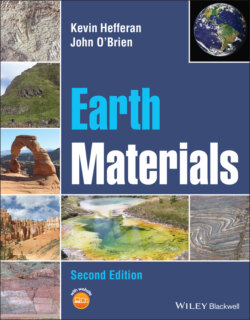Читать книгу Earth Materials - John O'Brien - Страница 108
4.6.4 Weiss parameters
ОглавлениеWeiss parameters provide a method for describing the orientation of sets of crystal faces or planes in relationship to the crystallographic axes. They are always expressed in the sequence a : b : c, where a represents the relationship of the planes to the a‐axis (or a1‐axis), b represents the relationship between the planes and the b‐axis (or a2‐axis) and c depicts the relationship between the planes and the c‐axis (or a3‐axis). A unit face or plane that cuts all three crystallographic axes at ratios that correspond to their axial ratios has the Weiss parameters (1 : 1 : 1). Mathematically, if we divide the actual lengths at which the face or plane intercepts the three axes by the corresponding axial lengths, the three intercepts have the resulting ratio l : l : l, or unity, which is why such planes are called unit planes. Again, using the pseudo‐orthorhombic mineral staurolite as an example, if we divide the actual intercept distances by the axial lengths, the resulting ratios are 0.47/0.47 : 1.00/1.00 : 0.34/0.34 = 1 : 1 : 1. Even if we utilize the magnitudes of the dimensions, the three resulting numbers have the same dimensional magnitude, and so their ratio reduces to 1 : 1 : 1.
As discussed in the section on unit faces and planes, many planes intersect all three crystallographic axes. Unit faces or planes (1 : 1 : 1), such as those in Figure 4.19, intersect all three axes at lengths that correspond to their axial ratios. Other sets of planes, however, intersect one or more axes at lengths that do not correspond to their axial ratios. A face or plane that intersects all three crystallographic axes at different lengths relative to their axial ratios is called a general face. The Weiss parameters of such a face or plane will be three rational numbers that describe the fact that each axis is intersected at a different proportion of its axial ratio. There are many sets of general planes. For example, a general plane with the Weiss parameters (1 : 1/2 : 1/3), shown in Figure 4.20, would be a plane that intersects the c‐axis at one‐third the corresponding length of the c‐axis and the b‐axis at one‐half the corresponding length of the b‐axis. Since many general faces are possible, for example (1 : 1/2 : 1/3) or (1/2 : 1 : 1/4), it is possible to write a general notation for all the faces that intersect the three crystallographic axes as (h : k : l) where h, k, and l express intercepts with a, b, and c, respectively.
Many crystal planes intersect the negative ends of one or more crystallographic axes. The location and/or orientation of these planes are not the same as those of planes that intersect the positive ends of the same axes. Planes that intersect the negative ends of one or more crystallographic axes are indicated by placing a bar over their Weiss parameters. For example, the dashed plane in Figure 4.20 has the Weiss parameters ( ).
Mineral planes may be parallel to one or two crystallographic axes. How do we determine the Weiss parameters for such faces and planes? The Weiss parameters of any face or plane that is parallel to a crystallographic axis are infinity (∞) because the plane never intersects the axis in question. If a set of planes is parallel to two crystallographic axes and intersects the third, it is assumed to intersect that axis at unity. Planes that are parallel to the a‐ and b‐axes and intersect the c‐axis have the Weiss parameters (∞ : ∞ : 1). Planes parallel to the b‐ and c‐axes that intersect the a‐axis have the Weiss parameters (1 : ∞ : ∞). Planes that cut the b‐axis and are parallel to the a‐ and c‐axes (Figure 4.21a) have the Weiss parameters (∞ : 1 : ∞). Each set of planes, with its unique relationship to the crystallographic axes possesses its own unique Weiss parameters. If a set of planes intersects two axes and is parallel to the third, only one of the Weiss parameters will be infinity. The other two will be one if, and only if, the two axes are intersected at lengths corresponding to their axial ratios. Therefore, the Weiss parameters (1 : ∞ : 1) represent planes that parallel the b‐axis and intersect the a‐and c‐axes at unit lengths. Similarly the Weiss parameters (1 : 1 : ∞) are those of planes that cut the a‐ and b‐axes at unit lengths and are parallel to the c‐axis (Figure 4.21b).
Figure 4.20 Faces with different Weiss parameters on an orthorhombic crystal.
Figure 4.21 (a) The darkened front crystal face possesses the Weiss parameters: (1 : ∞ : ∞). (b) The face outlined in green possesses the Weiss parameters (1 : 1 : ∞).
Having begun to master the concepts of how Weiss parameters can be used to represent different sets of crystal planes with different sets of relationships to the crystallographic axes, students are generally thrilled to find that crystal planes are commonly referenced, not by Weiss parameters, but instead by Miller indices.
